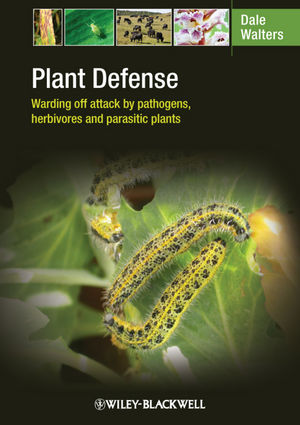Plant Defense: Warding off attack by pathogens, herbivores and parasitic plantsISBN: 978-1-4051-7589-0
Paperback
248 pages
October 2010, Wiley-Blackwell
 |
||||||
Chapter 1. Why Do Plants Need Defenses?
1.1 Plants as sources of food.
1.2 Organisms that use plants as food.
1.2.1 Microorganisms.
1.2.2 Parasitic angiosperms.
1.2.3 Nematodes.
1.2.4 Insects.
1.2.5 Vertebrates.
1.3 Impact of infection and herbivory in natural and agricultural
ecosystems.
1.3.1 Microorganisms.
1.3.2 Parasitic angiosperms.
1.3.3 Nematodes.
1.3.4 Insects.
1.3.5 Vertebrates.
1.4 Conclusions.
Recommended reading.
References.
Chapter 2. What Defenses Do Plants Use?
2.1 Introduction.
2.2 Defenses used against pathogens.
2.2.1 Background.
2.2.2 Passive or preexisting defenses.
2.2.2.1 Preexisting structural defenses.
2.2.2.2 Preexisting chemical defenses.
2.2.3 Active or inducible defenses.
2.2.3.1 Inducible structural defenses.
2.2.3.2 Inducible chemical defenses.
2.2.4 Defenses used against pathogens—the next step.
2.3 Defenses used against parasitic plants.
2.3.1 Background.
2.3.2 Preattachment defense mechanisms.
2.3.3 Prehaustorial defense mechanisms.
2.3.4 Posthaustorial defense mechanisms.
2.4 Defenses used against nematodes.
2.4.1 Background.
2.4.2 Passive or preexisting defenses.
2.4.3 Active or inducible defenses.
2.4.3.1 Phenylpropanoid metabolism.
2.4.3.2 Hypersensitive response.
2.5 Defenses used against herbivorous insects.
2.5.1 Background.
2.5.2 Physical barriers.
2.5.2.1 Waxes on the leaf surface.
2.5.2.2 Trichomes.
2.5.2.3 Secretory canals.
2.5.2.4 Leaf toughness and leaf folding.
2.5.3 Chemical defenses.
2.5.3.1 Terpenes.
2.5.3.2 Phenolics.
2.5.3.3 Nitrogen-containing organic compounds.
2.5.3.4 Arthropod-inducible proteins.
2.5.3.5 Volatile compounds.
2.6 Defenses used against vertebrate herbivores.
2.6.1 Background.
2.6.2 Physical defenses.
2.6.3 Chemical defenses.
2.6.3.1 Phenolic compounds.
2.6.3.2 Terpenoids.
2.6.3.3 Nitrogen-containing compounds.
2.6.3.4 Other chemicals.
2.6.3.5 A final word on chemical defenses against vertebrate
herbivory.
2.7 Defenses used against neighboring
plants—allelopathy.
2.7.1 Background.
2.7.2 Allelopathy and the black walnut.
2.7.3 Allelopathy and the Californian chaparral.
2.7.4 Allelopathy and spotted knapweed.
2.8 Conclusions.
Recommended reading.
References.
Chapter 3. Sounding the Alarm: Signaling and
Communication in Plant Defense.
3.1 Introduction.
3.2 Signaling in plant–pathogen interactions.
3.2.1 Introduction.
3.2.2 Local signaling and basal resistance.
3.2.2.1 SA signaling.
3.2.2.2 JA signaling.
3.2.2.3 ET signaling.
3.2.2.4 Signaling involving other plant hormones.
3.2.3 Systemic signaling and induced resistance.
3.2.3.1 Induced resistance.
3.2.3.2 Signaling during SAR.
3.2.3.3 Signaling during ISR.
3.2.3.4 Priming.
3.2.4 Volatile signaling.
3.3 Signaling in plant–nematode interactions.
3.3.1 Introduction.
3.3.2 SA signaling.
3.3.3 JA signaling.
3.4 Signaling in plant–insect herbivore interactions.
3.4.1 Introduction.
3.4.2 Local signaling.
3.4.2.1 JA signaling.
3.4.2.2 ET signaling.
3.4.2.3 SA signaling.
3.4.2.4 Specificity and regulation of jasmonate-based
defenses.
3.4.3 Systemic signaling.
3.4.3.1 Systemin.
3.4.3.2 JA signaling.
3.4.3.3 Within leaf signaling.
3.4.4 Volatile signaling.
3.4.5 Priming.
3.5 Signaling in interactions between plants and vertebrate
herbivores.
3.6 Signaling in interactions between plants and parasitic
plants.
3.7 Conclusions.
Recommended reading.
References.
Chapter 4. Plant Defense in the Real World: Multiple
Attackers and Beneficial Interactions.
4.1 Introduction.
4.2 Dealing with multiple attackers: cross-talk between signaling
pathways.
4.2.1 Trade-offs associated with triggering SA-mediated
defenses.
4.2.1.1 SA suppression of JA-induced defenses.
4.2.1.2 Molecular basis of SA suppression of JA defenses.
4.2.1.3 Ecological costs of resistance to biotrophic versus
necrotrophic pathogens.
4.2.1.4 Trade-offs with mutualistic symbioses.
4.2.1.5 Effects of SA- and JA-mediated defenses on bacterial
communities associated with plants.
4.2.2 Triggering SA-dependent defenses does not always compromise
defense against insect herbivores.
4.2.3 Trade-offs and positive outcomes associated with triggering
JA-dependent defenses.
4.2.4 Putting it all together: orchestrating the appropriate
defense response.
4.3 Can beneficial plant–microbe interactions induce
resistance in plants?
4.3.1 Introduction.
4.3.2 Induction of resistance by mycorrhizas.
4.3.3 Resistance induced by endophytic and other beneficial
fungi.
4.4 Conclusions.
Recommended reading.
References.
Chapter 5. The Evolution of Plant Defense.
5.1 Introduction.
5.2 Hypotheses of plant defense.
5.2.1 The growth–differentiation balance hypothesis.
5.2.2 Optimal defense hypotheses.
5.2.3 Plant apparency hypothesis.
5.2.4 The carbon–nutrient balance hypothesis.
5.2.5 The growth rate hypothesis.
5.2.6 Hypotheses of plant defense—where next?
5.3 Evolution of plant defense strategies.
5.3.1 The univariate trade-off hypothesis.
5.3.2 The resistance–regrowth trade-off hypothesis.
5.3.3 The plant apparency hypothesis.
5.3.4 The resource availability hypothesis.
5.3.5 Plant defense syndromes.
5.4 Patterns of plant defense evolution.
5.4.1 Adaptive radiation.
5.4.2 Escalation of defense potency.
5.4.3 Phylogenetic conservatism.
5.4.4 Phylogenetic escalation and decline of plant defense
strategies.
5.5 Why do plants have induced defenses?
5.5.1 Costs.
5.5.1.1 Allocation costs associated with induced responses to
herbivory.
5.5.1.2 Allocation costs associated with induced responses to
pathogens.
5.5.2 Targeting of inducible direct defenses.
5.5.3 Targeting of inducible indirect defenses.
5.5.4 Dispersal of damage.
5.5.5 Possible role of pathogenic bacteria in the evolution of
SAR.
5.5.6 Conclusion.
5.6 The coevolutionary arms race .
5.7 Conclusions.
Recommended reading.
References.
Chapter 6. Exploiting Plant Defense.
6.1 Introduction.
6.2 Using plant resistance to protect crops—breeding.
6.2.1 Introduction.
6.2.2 Breeding for resistance.
6.2.2.1 Sources of resistance.
6.2.2.2 Breeding methods and selection strategies.
6.2.3 Resistance in practice.
6.2.4 Types of resistance.
6.2.4.1 Monogenic resistance.
6.2.4.2 Polygenic resistance.
6.2.4.3 Durable resistance.
6.2.4.4 Gene-for-gene concept.
6.2.5 Making life more difficult for the attacker.
6.3 Using plant resistance to protect crops—induced
resistance.
6.3.1 Introduction.
6.3.2 Induced resistance for pathogen control.
6.3.3 Induced resistance for control of herbivorous insects.
6.3.4 Induced resistance for control of nematodes and parasitic
plants.
6.4 Using plant resistance to protect crops—biotechnological
approaches.
6.4.1 Introduction.
6.4.2 Engineering resistance to pathogens.
6.4.3 Engineering resistance to insects.
6.4.4 Prospects for using transgenic resistance.
6.5 Conclusions.
Recommended reading.
References.
Index.



